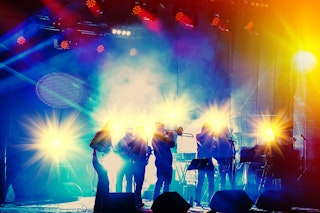Tri‑Cities History at a Glance
Think you know the Tri-Cities? There’s a lot that you might not know that makes the Tri-Cities truly special and remarkable.
From the dramatic Ice Age floods that sculpted the landscape to the evidence of Native American tribes living here for over 10,000 years, there's so much history to discover.
Richland’s Manhattan Project changed the course of human history, and today, the region is known for its award-winning wines and incredible scientific breakthroughs.
The Tri-Cities is full of fascinating stories and hidden gems waiting to be explored. Here’s a look at our roots that got us to where we are today.
Millions of years ago | Volcanic Lava Flows & Giant Animals
Basalt lava flows east from Washington’s five volcanoes, forming a basin of basalt bedrock. Giant prehistoric animals roam the Columbia Basin, including the Giant Ground Sloth and the Columbian Mammoth. Today, you can visit an active dig site of a Columbian Mammoth at Coyote Canyon Mammoth Dig in Kennewick, Washington. [link to McBones]. Most likely, there were also dinosaurs that roamed this area, but the remains were flushed away by the Ice Age floods that crashed through this area…
15,000 to 13,000 years ago | Ice Age Floods
During the Ice Age, the ice dam at Glacial Lake Missoula broke, sending a 500-foot-tall wall of water careening at 65 miles per hour, carving out the landscape and depositing large boulders that can still be seen today, called erratics. This flood bottlenecked at Wallula Gap, flooding Eastern Washington to form the enormous Lake Lewis. Multiple similar floods occur, depositing rich sediment, making the Columbia Basin ideal for agriculture and securing its future as the heart of Washington's agricultural industry.
The Native American name for Rattlesnake Mountain, Lalíik, means “land above the water.” Historians believe this refers to the fact that Rattlesnake Mountain was one of the few peaks above the floodwaters at that time, and the name suggests that history has remained a part of Native American oral tradition for thousands of years. Lake Lewis reached a maximum height of 1,250 feet, the same as the Empire State Building.
9,000 years ago | Native American Heritage
Native American tribes populated the area here at the confluence of the Columbia, Snake, and Yakima rivers, which served as a vital meeting place for hunting, fishing, and trading. About 9,000 years ago, a man in his mid-40s walked along the bank of the Columbia River in what is now Kennewick, Washington. His skeleton, discovered in 1996, became known as Kennewick Man. Testing revealed he was genetically related to the Native Americans of the Confederated Tribes of the Colville Reservation. His remains are now buried at a site known only to tribal elders.
1805 | Lewis & Clark
Lewis & Clark camped here at the confluence of the Snake and Columbia Rivers in 1805 as they explored the Pacific Northwest with the help of their interpreter Sacajawea. Where they stayed is now the site of the Sacajawea Historical State Park. Today you can follow in their footsteps on the Sacagawea Heritage Trail.
Late 1800s to Early 1900s | A Railroad & Farming Community
The first of the three Tri-Cities, Pasco, starts out as a dusty but bustling railroad hub. The invention of irrigation makes agriculture possible. Kennewick becomes the next of the Tri-Cities to become a town in 1905. A handful of small farming communities dot the Columbia River further north, including Richland, Hanford, and White Bluffs, producing pears, apples, vegetables, and grapes for wine.
World War II | The Manhattan Project
The government evicts the 1,200 residents of Hanford, Richland, and White Bluffs to make way for The Manhattan Project’s top-secret Hanford Site, where they built the world’s first full-scale nuclear reactor to produce plutonium for an atomic bomb. The site went from dirt to producing plutonium in just 2 years. Architect Gustav Pehrson was given less than 90 days to design a city for the workers to live in. He designed the famous Alphabet Houses to house thousands of workers moving into the town of Richland in a short amount of time, most of which are still around today. The historic B Reactor can be toured today at the Manhattan Project National Historical Site.
1950s & 1960s | Cold War Boom
1970s to Today | Wine & Agriculture and Science & Innovation Boom
Due to significant government work and thriving agricultural and wine industries, the Tri-Cities are continually growing and tend to be recession-proof. The region leads in science, research, and innovation.
Wine grapes were first planted here in 1972, and Washington State now boasts over 1,200 wineries. The Wine Science Center at WSU Tri-Cities conducts groundbreaking research on winemaking challenges, such as the effects of climate change and "smoke taint" from wildfires.
Scientists at the Pacific Northwest National Laboratory continue to make significant discoveries and develop new technologies, two famous ones being the Xerox machine and airport body scanner.
The Laser Interferometer Gravitational-Wave Observatory (LIGO), a first-of-its-kind facility, proved Einstein’s theory of general relativity and earned a Nobel Prize in Physics for its study of gravitational waves.
The love for science inspires residents, too. NASA Astronaut Kayla Barron, a graduate of Richland High School, worked aboard the International Space Station. A signed photo of her in the ISS Cupola overlooking Earth, wearing a Richland Bombers T-shirt, is displayed at Richland’s REACH Museum.
































